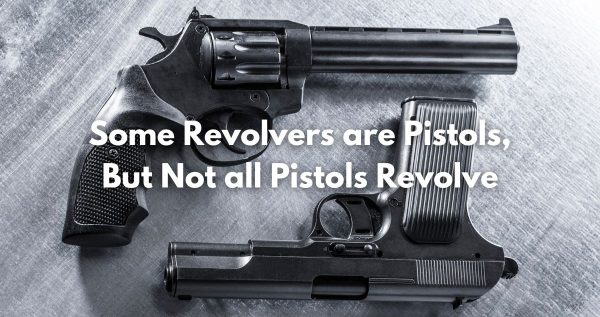
Outside of the revolving chamber that gives revolvers their name, there are a few main differences between revolvers and pistols like the amount of recoil you’ll feel, and the chamber capacity which is beneficial for self defense that make them different. These differences will help you determine which type of handgun is the right one for your needs.
Fun fact: The first version of a revolver was created in the 15th century and was known as a hand canon.
If you’re using the ATF’s definition, pistols are any form of handgun where the cartridges are not contained in a revolving chamber. An industry standard definition for revolvers would be the opposite of a pistol where the cartridges are held and loaded from a rotating chamber.
Outside of the definitions, here’s some more similarities and differences between them.
Both pistols and revolvers are good for self defense, but in different situations. If you’re an outdoors enthusiast, a revolver won’t give you enough rounds to stop or deter a bear or a wild boar as larger prey will likely need a rifle. But to be fair, no handgun is going to fully neutralize a bear. There are handguns that are better for defense against bears though.
Revolvers have six cartridges giving them the name six shooter, where a Glock could have 17 or more bullets giving you additional resources to slow down or deter the threat.
You could make the argument that a revolver can handle a larger caliber bullet, but that comes with extra recoil and bears can charge at speeds over 20mph. This includes the Grizzly bear which has the ability to charge at 35 mph and maintain speeds up to 28 miles per hour over a 2 mile stretch. That is faster than the average domestic horse!
If you live in an urban or suburban area and your hands are smaller, it may be harder to charge the slide on a standard pistol. The difficulty in charging the slide may prevent you from getting rounds off in time where it may be easier to fire the second shot from the revolver, but this depends on the specific firearm you carry and your experience with it.
If you run out of ammo, it’s going to be faster and easier to reload a magazine than popping the bullets out of a revolver. When seconds and rounds matter, the pistol wins over the revolver.
Revolvers are heavier and have more recoil than pistols, and this makes them less appealing than a pistol for self defense. But when it comes to larger and heavier ammo, the revolver is going to pack a punch as they are designed to handle this.
The two are fairly similar in accuracy as accuracy is more dependent on the barrel length. But recoil also impacts accuracy for the second shot, so the pistol will beat the revolver in self defense situations where your hands may be more shaky and you’re feeling nervous. The need to recover from a recoil could cost you precious seconds.
If the firearm is for show or fun, like shooting targets on a ranch or for general concealed carry, revolvers are great. They’re iconic pieces of firearm history and pop culture. And revolvers tend to be less expensive than pistols, so you could save some money if that is a deciding factor for you.
Both pistols and revolvers are storable in a standard handgun safe, so there is no difference with regards to storage, but there is with maintenance.
Revolvers have a simpler design and that makes them easier to clean than a pistol. You still have to strip both firearms down, but you’ll save a bit of time with your revolver, not much, but a bit.
Here’s how we recommend choosing between the two if you’re shopping. Both can work for multiple purposes, but as you’ve learned above, they have slight advantages in certain situations.
Pistol | Revolver | |
Defense in the wilderness | X | |
Defense in urban settings | X | |
Self Defense in general | X | |
Has less recoil | X | |
Fun and sport | X | |
Price | X |
Either way you go, both pistols and revolvers can work for self defense and target practice. Pistols tend to have the upper hand when it comes to defense when compared to revolvers, which is why pistols are the preferred firearm for law enforcement. If you found this guide helpful, join our newsletter by entering your email below for more content like it.